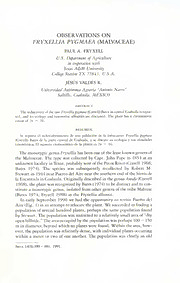Table Of ContentOBSERVATIONS ON
FRYXELLIA PYGMAEA (MALVACEAE)
PAUL A. FRYXELL
U.S. DepartmentofAgriculture
incooperation with
A&M
Texas University
CollegeStationTX 77843, U.S.A.
JESUS VALDES R.
UnifersidaclAutonomaAgraria 'AntonioNarro"
Saltilk. Coahmla. MEXICO
ABSTRAC;]'
Therediscoveryoftherarel-ryxe/iuipyi^maea(CorrcU)BaresincenrralCoahuilaisrepor-
ted,anditsecologyandtaxonomicaffinitiesarediscussed.Theplanthasachromosome
countot2f/ = 16.
RliSUMI'N
Se reporra el redescnbrimienrode unapoblacicMide laintrecuenreFryxtllicipyiinuwa
((Worrell)Batesdela|iartecenrraldcCoahuila, ysediscutesuect)logiaysusafinidades
raxonomicas.lilntimerocromoscimicodelaplantaes2« = 16.
ThemonotypicgenusVryxelliahasbeenoneofrheleastknowngeneraof
the Malvaceae. ThetypewascollectedbyCapt.JohnPopein IHVlatan
unknownlocalityinTexas,probablywestofthePecosRiver(Correll 1968;
Bates 1974). The species was subsequently recollected by Robert M.
Stewartin 1941nearPuertodelAirenearthesouthernendoftheSierrade
laEncantadainCoahuila. OriginallydescribedinthegenusAnoda(Correll
1968),theplantwasrecognizedbyBates(1974)tobedistinctandtocon-
stituteamonotypicgenus,isolatedfroinothergeneraofthetribeMalveae
(Bates 1974; Fryxell 1988)as theFryxelliaalliance.
Inearly September 1990wehad theopportunity torevisit Puertodel
Aire(Fig. 1)inanattempttorelocatetheplant.Wesucceededinfindinga
populationofseveralhundredplants,perhapsthesamepopulationfound
byStewart. Thepopulationwasrestrictedtoarelativelysmallareaof"dry
openhillside."Theareaoccupiedbythepopulationwasperhaps 100—150
mindiameter,beyondwhichnoplantswerefound.Withinthearea,how-
ever,thepopulationwasrelativelydense,withindividualplantsoccurring
within ameterortwoofoneanother. Thepopulationwasclearlyanold
SuiA l4(3):399-4()4. 1991
400
one, with many individual plants having extensiveperennial rootstocks.
Whatedaphicorotherfactorsareinvolvedinrestrictingthepopulationto
thissmallareawerenotimmediatelyevidentandarenotknown. Itmaybe
speculated, however, that the population observed is in fact an ancient
clone, spreading laterally by proliferating rootstocks. Even though the
planthasanapparentlyefficientmethodofseeddispersal,andsubsequent
germination tests have shown the seeds to be fully viable, seedling es-
tablishmentat anew locality in theseveredesertenvironmentofcentral
o
>
JoseI'IGCja.rcIi.a)P,ortroioancocto"mLpaaMnoynr"aA"Cmiaazpe,rtpe.er23o,lit>ih"eM.(;ihpishoufarhhucaCnhiDheusearhtuaRnegDieosne,rrARegSiuopnp"le(mceonmptilreodtbliye
("hituialinanOesertI'iora"(byJ. HenricksonandR.M.Srraw, 1976).
401
Coahuilamaybearelativelyrareevent,dependentuponafavorablepattern
ofrainfallinaparticularyear.Aperennial,caespitosehabit,coupledwith
vegetativepropagationbyrootproliferation, maybethesecretofsurvival
for this species in this habitat. Unfortunately, we did not consider this
possibilityatthetimewewereinthefieldwhen,asatestofthishypothe-
sis, we could have looked for subterranean mterconnections ofadjacent
plants.
The Plants
Summerrainfallinthisareahadbeenaboveaveragein 1990,sothatthe
plants were in relativelygood condition. Allexcept theyoungestplants
werefruiting,withflowersandbudsstilldeveloping.Fruitswererelatively
abundant, indicating that the plants were vigorously reproductive. In-
dividualplantsformsmallrosettesontheorderof15cmdiameter. They
are not acaulescent (as described), although they are indeed caespitose.
Eachplanthasonetoseveralshortstems 1-2cmlongwithveryshort,
crowdedinternodes. Therootstocksarethick(ca. 1 cmormoreindiame-
ter),wellbranched,andpenetratedeepintothegravellysoil;therootsare
apparently food-storageorgans.
Budsandflowerswereobservedandphotographed,onthebasisofwhich
corollacolorcanbedescribedasarichorange(Fig. 2). Afterabscissionof
thecorolla,theaccrescentcalyxultimatelyflarestoarotateformand,asthe
fruitmatures, takesonareddishcolorationontheexposed(adaxial)side.
Uponmaturationofthefruit,abscissionisatthebaseofthecalyx,sothat
thecalyxandthecontainedfruittogetherarethediaspore.Thecalyxevid-
entlyservesasasail tobe blownoverthegroundasaformofwinddis-
persal.
Stylesandstigmaswereobservedandwerefoundtohavetheabruptly
capitate form andglabrouscondition thatarecharacteristicofthegenus
Anocla. Thesefeatures, togetherwith thegeneralaspectofthefruits, ex-
plainCorrell'soriginalplacementofthisspecies inAnoda. On theother
hand, thedorsalspur,whichaccountsfortheresemblanceofthemericarps
oi'Fryxel/iatothoseofAnoda,differsinthatthespurclearlyhasasutureof
dehiscence inFryxeiliaand but not inAnoda.
Themericarpsof/^pygmaea(Correll)BatesarewellillustratedbyBates
(1974, Fig. 1, Ab, Ac). Oneitemofinformationcanbeadded, however.
Theendoglossumisinfactadividedstructure,consistingoftwoawl-like
internalgrowthsextendingforwardfromthedorsalwall,notasinglesuch
growthaswasillustrated. Thus, theendoglossumshowsaresemblanceto
that found in the genus Batesimalva, most nearly to that found in B.
p/ilchella Fryx.
4x
l-ICi. 2.i-r)XLllu!pyi^iiuiiii. Plant_i;r(>\vninrhc^qrc-cnhouscfromseed.
403
Questions remainconcerning theaffinities ofthegenus Vryxdlia. The
stigmamorphologysuggestsanaffiliationwithAnoda. Theendoglossum
structuresuggestsanaffihationwithBcitaiinuilra,asdoestheleafformand
geographicaldistribution. Furthermore, theaccrescentcalyxofV.pygniaea
showssomeresemblancetothesomewhataccrescentcalyxofB.piikhdla.
However,othercharacters,suchasthecaespitosehabit,theorangecorolla,
thestrongly accrescent calyx, and thedetailed fruit morphology, clearly
justify Bates' segregation of Vryxdlia as a distinct genus. Conceivably,
Vryxdlui may beaconnecting link(by redtictionofthe uppercell ofthe
mericarp, with the endoglossum remaining as a vestige of tliis former,
hypothesizedcondition)betweenBates'ni/cdvctandAnode/andthusprovide
an indicationofthephylogcneticoriginoftheAnoda-Pcripteraalliance. A
chromosomecountof2// = 16wasobtained forRpygmaea(Fig. 3). The
base chromosome number forA}i()dct is x = 15 (Bates 1987), forBatesi-
nicdvay. = 16(Bates&Blanchard 1970). Pollenaperturenumber(Hashmi
1970, Fryxell 19<S8), is 3 forVryxdlid, 3—4forBatesmudva, andusually
30ormoreforAnoda.ThesedataindicateaplacementofFryxelliacloserto
ICi.VCliromosomcsofV'nA.///.//n.t,'"'''"'' '"P'mctaphascI(X2160);horrom,diplotcncfX833).
404
Bcites/ii/cilvci rhaa toAnocla.
Finally, it may be asked if this species should tx' considered as
"threatened or endangered." The plants observed were locally abundant
andhighlyIruitlul, producingabundantviableseeds, butwereveryloca-
lized indistribution. Whatecologicalfactorsmediatethislocalizationare
Luiknown.Onlyonepopulationofthespeciesiscertainlyknown, andthe
species can arguably be described as the rarest plant ofthe Chihuahuan
Desert. Yet it was also collected inTexas by Pope, probably somewhere
westotthePecosRiver,adirectdistanceof200—300km(ormore)tothe
northwest. An ample amount of relatively undisturbed, apparently
suitablehabitatliesintheinterveningarea, inwhichthespeciesmightbe
expected tooccur. Muchotthisareais unexplored boranicallyoratleast
poorlyexfilored. Therefore, itseemsmoresuitabletodescribethisspecies
as"insufficientlyknown"ratherthan"threatened,endangered,orextinct,"
as listed by ValdesandJohnston (I9H8).
Therecentcollection,duplicatesofwhichwillbedistributed,iscitedas
follows:
MI-:XIC():Comk'ii.a:Mpio.ik-Ocampo,Sierrailclalincantada(28°1-1/2'N, 102°
2^'W),air. I25()m,SSep1990,I'nxill.Vuhles.Carnnizu.Vdzijitez&Meza)0(J6(ANSM,
BRri'-SMLI, pt,aiKJorherduplicatx-srohedisrribi.irei.1).
A(;KNOWLi;1)(;mi-:nts
Appreciation is extended to Miguel A. Carranza P, Ricardo Vazquez
Aldape, andOrlandoMeza, whohelpedwiththefieldwork,andtoJuan
Diaz-ColonandDavidM. Stelly, whoprovidedthechromosomeprepara-
tionsand {photographs.
Ri;i'i;Rt;Nc:F.s
IMT2H6S:,95D-.M1.00.197i. I'ryxdlhi, a new ^t;enLi,s ofNorrh American Malvaceae. Brirronia
HAll:.S. D.M. ]9(S7. (Jiromosome numbers and evolution m AuocLt and Pcnpltrn
(Malvaceae). Aliso ll:52.S-5.^1.
lUTliS,D.M.andO.j.BLANCHARD,Jr. 1970.Chromo.somenumbersintheMalvalcs.
II.Newororherwisenoreworthycount.srelevanrrocla.s.siticarioninrhcMalvaceae,rribe
Malveae. Amer.j. Bor. '57:927-931.
CORRliLL,1),S. I96,S.Someaddirion.sandcorrecrion.srorheHoraofTexa.s-Vl.Wn^luia
4:7-l-7H,
TIRIYAXSlH'MLIL,.SR.AH.. 119987.0S.. MTahlevapcaelayenoolfogMyexiofcor.heSy.Msatl.vaBocre.aeMoonfo,Tuerx.as.25:PhI.-D5.22D.isserration,
TexasA&M IJniversiry. (UniversityMicrofilmsno. 70-16729)
VALDl'S, J. and M.C. JOHNSTON. 1988. Boranical resource and flonsric diversiry
depletioninrheChiluiahuanDeserrRegionofMexico.ThirdSymposiumonResources
ottheChiluiahuanDesert:U.S.andMexico(abstract). 10-12November1988arSul
RossSrareUniversity,Al|-iine,Texas.

